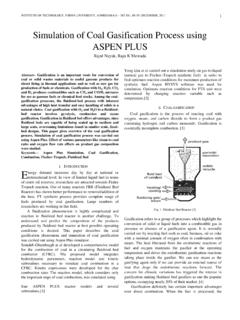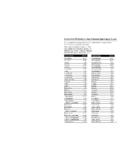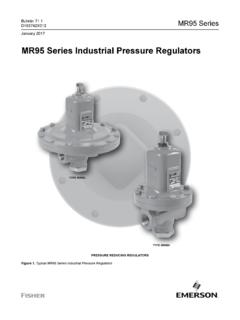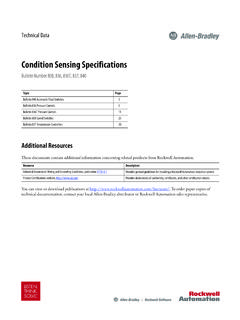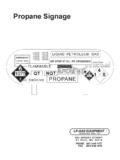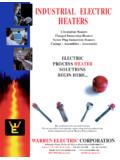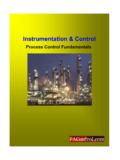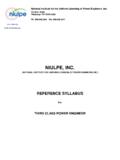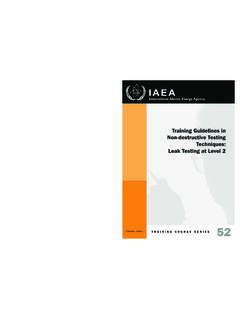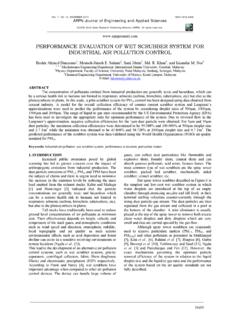Transcription of Performance Characteristics of an Air-Cooled …
1 INSTITUTE OF TECHNOLOGY, NIRMA UNIVERSITY, AHMEDABAD 382 481, 08-10 DECEMBER, 2011 1 Abstract -- In this paper effects off air flow pattern as well as ambient conditions are studied. Unfortunately ACC becomes less effective under high ambient temperature and windy conditions. Fin cleaning plays a vital role in heat rejection. External surface cleaning improves air side heat transfer coefficient. Ambient conditions affect the steam temperature and heat rejection rate. It is observed that rise in wind velocity decreases thermal effectiveness of ACC up to considerable level.
2 Ambient temperature not only affects Performance of ACC at the same time turbine back pressure also increases with rise in ambient temperature. Skirts are effective solution to reduce the effect of wind on volumetric effectiveness. Hot air recirculation increases with wind velocity. Now a days wind walls are used to reduce this effect. Second option is to increase fan speed. It counter affects on electrical power consumption. Index Terms -- Ambient temperature, Hot air Recirculation, Thermal effectiveness I. INTRODUCTION ue to the decreasing availability and rising cost of cooling water, dry-cooling towers or direct Air-Cooled condensers (ACC s) are increasingly employed to reject heat to the environment in modern power plants incorporating steam turbines.
3 Unfortunately, with an increase in the ambient temperature, the effectiveness of these cooling systems decreases resulting in a corresponding reduction in turbine efficiency. The reduction in turbine output during hot periods may result in a significant loss in income, especially in areas where the demand and cost for power during these periods is high. II. DRY COOLING As the availability of water required for wet-cooling systems becomes more limited, modern power plants are increasingly employing indirect dry-cooling towers or direct Air-Cooled steam condensers to condense steam turbine exhaust vapor.
4 Direct Air-Cooled condenser units in power plants usually consist of finned tubes arranged in the form of a delta or A-frame to drain condensate effectively, reduce distribution steam duct lengths and minimize the required ground surface area. A-frame direct Air-Cooled steam condenser units are normally arranged in multi-row or multistreet arrays. Each street consists of three to five main condenser units with a dephlegmator or secondary reflux condenser connected in series. The addition of the dephlegmator increases the steam flow in the main condenser units to such an extent that there is a net flow of steam out of every tube.
5 This inhibits the accumulation of non4 condensable gases in the tubes that may lead to corrosion, freezing or a reduction in the heat transfer capability of the system. Unlike the thermal Performance of wet-cooling systems, which are dependent on the wet bulb temperature of the ambient air, an Air-Cooled system s Performance is directly related to the dry bulb temperature. The ambient dry bulb temperature is normally higher than the wet bulb temperature and experiences more drastic daily and seasonal changes. Although Air-Cooled systems provide a saving in cooling water, they experience Performance penalties during periods of high ambient temperatures.
6 III. CURRENT WORLD WIDE ACC SCENARIO Selection of cooling technology for use in power plants is an economic decision which is frequently influenced by local environmental and political factors. In the early days, use of dry cooling methods was sometimes the only feasible option due to scarcity of water at otherwise attractive plant sites in arid and semi-arid regions of the world. However, the combined trends of increasing demands for power, more widespread scarcity of available water for cooling and increasing costs of water and tighter environmental restraints related to use of wet cooling systems served to broaden selection of the ACC option, in term of both number and size of units.
7 Worldwide installation of dry cooled power plants. Graph given above depicts the trends in installation of ACCs and indirect dry cooling systems on units >100MW since 1960. (Indirect designs employ water cooling of turbine condensate in a closed system arrangement with Air-Cooled exchangers used to reject the heat transferred to the cooling water during condensation.) From this figure it quickly Performance Characteristics of an Air-Cooled Condenser Under Ambient Conditions A. Rupeshkumar , B. Amitesh Paul, D. Anjana D. Saparia D INTERNATIONAL CONFERENCE ON CURRENT TRENDS IN TECHNOLOGY, NUiCONE 2011 2 becomes apparent that increased interest started around the mid 1980s has generally continued to grow, particularly over the last 10 years.
8 IV. THE IMPACT OF AIR COOLED CONDENSER ON PLANT DESIGN AND OPERATIONS. Air-Cooled condensers were first introduced into the power industry in the early 1970 s, but only during the last decade has the number of installations greatly increased, largely in response to the growing attention being paid to environmental concerns. The rising importance of this rather different technology for the condensing and recovery of exhaust steam calls for a broader understanding of the associated design and application principles involved, as well as of the Performance monitoring techniques and cleaning methods that have to be applied.
9 Over the past 30 years there has been a growing and competing demand for water for both domestic and industrial use and this has brought an increased interest in the use of air as a cooling medium in place of water. In the utility industry, the earliest applications for the Air-Cooled condensing of exhaust steam were modified Air-Cooled heat exchangers similar to those already in use by the process industries. Eventually, Air-Cooled condensers designed for the utility industry evolved into a configuration that recognized the special needs of condensing a large volume of low pressure vapor as well as the removal of non-condensable.
10 V. THE ENVIRONMENTAL PROTECTION AGENCY AND DRY COOLING In 2000, the Environmental Protection Agency conducted a comparative study of the environmental impacts of wet vs. dry cooling. Their conclusion was that the energy consumption per lb. condensate was higher for dry cooling than for wet cooling and that the atmospheric emissions associated with that energy consumption was also higher. These disadvantages are offset by the cooling water intake flow being reduced by 99% over that required by a once-through system; or 4-7% over a closed cooling water system.
